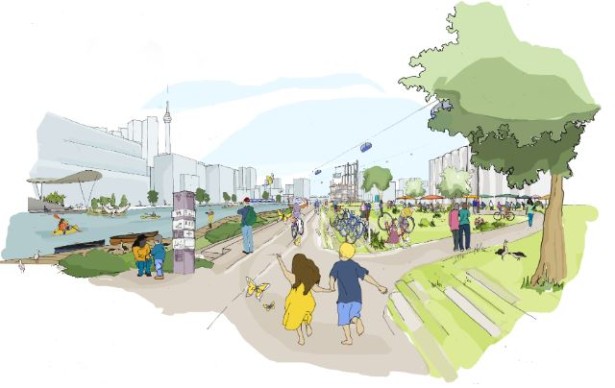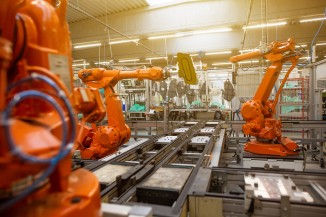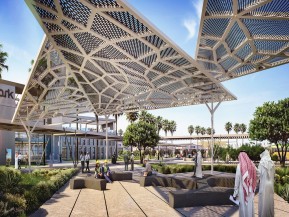Zigurat Global Institute of Technology
Blog / Disruptive Technologies
Smart City Series: Quayside development on Toronto’s waterfront
Categories

The concept of a smart city has ceased to be a technological fantasy and has evolved from a fancy buzzword to become our hope for a better future. During the month of February, we are going to cover in our blog some of the most remarkable examples of smart city implementation.
Last week we covered Barcelona’s journey becoming one of the most widely-recognized smart cities in the world. This week we are going to delve into the Quayside development of Sidewalk Toronto project, the development of an intelligent district in the eastern part of the Canadian city, on the shores of Lake Ontario. Toronto stands out for many reasons. With half of its 2.9 million population born outside the country, it is often regarded as ‘the most diverse and multicultural city in the world’. Toronto boasts 200 ethnic groups and some 140 languages are spoken there daily. But it’s not only the plurality of its citizens that makes Toronto one of the kind but rather its remarkable spirit of openness that has made the city a beacon the world looks to.
Challenges of Growth
Toronto is currently the fourth-largest city in North America and its population is expected to grow by 35 percent in the next 25 years, while the metro area is expected to grow 42 percent over the same period. The rapid rise of its technology sector (with an emerging focus around artificial intelligence) has been one of the keys to Toronto’s enormous economic prosperity. However, with the growth of the population, some substantial challenges have surfaced. For example, the housing prices have more than doubled over the last 10 years and the transit system has considerable difficulties to meet the demand. Toronto must also take action on climate change and find ways to reduce local energy use and greenhouse gas emissions. For these reasons and more, Toronto is the perfect city to advance solutions to common growth challenges. And as it happens, it also has the perfect place to do it: the city’s underdeveloped Eastern Waterfront. This project gives the perfect opportunity to execute a visionary plan that has the potential to make Toronto a global leader in urban innovation.
Sidewalk Toronto at Quayside
Quayside development is a joint effort by Waterfront Toronto and Alphabet’s Sidewalk Labs to come up with a whole ecosystem of innovation inhabited by people who have participated in the design of their spaces, their homes and their places of leisure. The project seeks to respond to the constant growth and the lack of affordable housing with the construction of an entire intelligent district from scratch.  The area is made up by 325 hectares located southeast of downtown Toronto. It will include the neighborhood of Quayside and will extend throughout a gigantic space called Port Lands. One of the demands of the citizens of Toronto, who have participated in the numerous brainstorming meetings held between the heads of Sidewalk Toronto and the neighbors, is to achieve through the implementation of this project the integration of this district with the rest of the city.
The area is made up by 325 hectares located southeast of downtown Toronto. It will include the neighborhood of Quayside and will extend throughout a gigantic space called Port Lands. One of the demands of the citizens of Toronto, who have participated in the numerous brainstorming meetings held between the heads of Sidewalk Toronto and the neighbors, is to achieve through the implementation of this project the integration of this district with the rest of the city. 
Objectives of Sidewalk Toronto
The project was born from the necessity to adequately respond to the housing crisis and the population growth tendencies, however, many other objectives have been defined since then, such as:
- Build a place where public spaces welcome families to enjoy outdoors all day and all night and where community ties are important. Through that community, it becomes possible to offer a superior quality of life for a diverse population of residents, workers, and visitors.
- Build a place that encourages innovation around energy, waste, and other environmental challenges to protect the planet. And in the process, create a destination for people, companies, startups, and local organizations interested in advancing solutions to the challenges facing cities.
- Make Toronto a global hub of urban innovation. Toronto’s already-thriving tech sector and developing innovations could benefit communities and neighborhoods elsewhere in the world
- Serve as a model for sustainable neighborhoods throughout Toronto and cities around the world.

How Do They Plan to Achieve All That?
The projected image of the future district is that of a place where tens of thousands of people live, work, study and have fun in an environment that fosters innovation. The strategies used for the implementation of that image include:
- Public transportation system that makes getting around more affordable, safe, and convenient than the private car;
- sustainable and affordable intermodal;
- autonomous vehicles for the transport of goods with special roads for their circulation;
- energy reuse systems and renewable sources;
- and a housing stock with materials and construction methods that reduce their costs and their effects on environment.
With all this, the people in charge of the project hope to reduce the cost of living by 14%, increase green spaces by 30%, reduce greenhouse gas emission levels by 67% and make their inhabitants recover one hour a day of their personal time, while improving their quality of life in terms of transport, in addition to revitalizing the economy in general.  To make this smart city into reality, the Canadian Government and the public company Waterfront Toronto, who is in charge of revitalizing 800 underutilized hectares along the shore of Lake Ontario, signed in October 2017 an agreement with the innovation company "Sidewalk Labs", of Alphabet, the parent company of Google, YouTube and Gmail, among others. In this public-private partnership agreement, the subsidiary of Alphabet has committed to contribute 50 million dollars, while the public company Waterfront Toronto has received 1,250,000,000 million dollars of state, provincial and municipal financing.
To make this smart city into reality, the Canadian Government and the public company Waterfront Toronto, who is in charge of revitalizing 800 underutilized hectares along the shore of Lake Ontario, signed in October 2017 an agreement with the innovation company "Sidewalk Labs", of Alphabet, the parent company of Google, YouTube and Gmail, among others. In this public-private partnership agreement, the subsidiary of Alphabet has committed to contribute 50 million dollars, while the public company Waterfront Toronto has received 1,250,000,000 million dollars of state, provincial and municipal financing.
How Is It Going So Far?
One of the key aspects for Sidewalk Toronto is to reach a broad consensus in the urban and technological development of the district. They also want to take into account the ideas and needs of the future neighbors. To achieve this, meetings with advisory councils and assemblies are being held. During these assemblies the participants have highlighted the need to have affordable housing and to ensure that the neighborhood is not an island within Toronto, but an integrated neighborhood. While many aspects of the life in this future smart district are still in development and up for discussion, others have begun to take shape. In August 2018, Sidewalk Labs gave to the local residents the first idea what the development could look like. One key component of the vision is building more timber buildings. Mass timber construction is a more sustainable building process and is also believed to be healthier for both construction workers and future occupants.  To avoid cold and rainy climate shutting down the outdoor activities, climate-controlled public spaces to block rain and snow will be designed. This will help to double the amount of usable outdoor hours. The project also plans to reinvent sidewalk experimenting with ‘dynamic street’ prototype that uses interactive and modular pavers. The kit of parts includes a variety of surfaces and tiny embedded LED lights that can denote use—walk vs. bike vs. basketball court—and create “lanes”. Thanks to the sensors in these pavers, Sidewalk Labs can track the way streets are used and adjust the design of the right-of-way on the fly. Sidewalk Toronto’s street hierarchy is also worth mentioning. A system of larger and smaller streets prioritizes movement by modes, which means that laneways are wide enough to allow vehicles to make deliveries in the morning or evening, but transform into people-friendly plazas during the day. As for the contribution of Sidewalk Labs, they have deployed digital kiosks that provide free Wi-Fi, real-time transit information, and historical photos of the area. More recently, the data mobility startup Coord with the multimodal trip-planning Router app was introduced to allow urban dwellers to use Google Maps to check transit times and modes across bike share, public transport, car share, and ride-hailing options, and then book or pay for their chosen mode right in the app.
To avoid cold and rainy climate shutting down the outdoor activities, climate-controlled public spaces to block rain and snow will be designed. This will help to double the amount of usable outdoor hours. The project also plans to reinvent sidewalk experimenting with ‘dynamic street’ prototype that uses interactive and modular pavers. The kit of parts includes a variety of surfaces and tiny embedded LED lights that can denote use—walk vs. bike vs. basketball court—and create “lanes”. Thanks to the sensors in these pavers, Sidewalk Labs can track the way streets are used and adjust the design of the right-of-way on the fly. Sidewalk Toronto’s street hierarchy is also worth mentioning. A system of larger and smaller streets prioritizes movement by modes, which means that laneways are wide enough to allow vehicles to make deliveries in the morning or evening, but transform into people-friendly plazas during the day. As for the contribution of Sidewalk Labs, they have deployed digital kiosks that provide free Wi-Fi, real-time transit information, and historical photos of the area. More recently, the data mobility startup Coord with the multimodal trip-planning Router app was introduced to allow urban dwellers to use Google Maps to check transit times and modes across bike share, public transport, car share, and ride-hailing options, and then book or pay for their chosen mode right in the app. 



